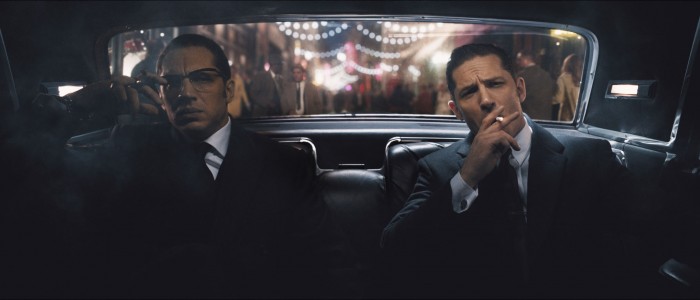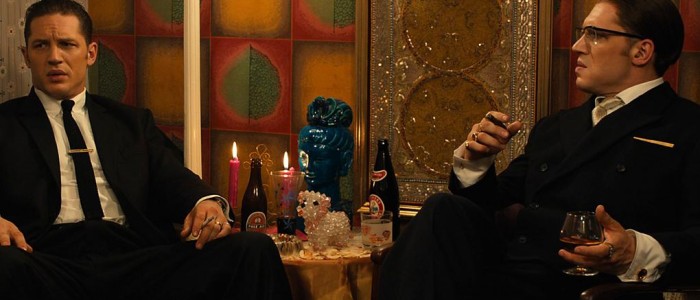Interview: How 'Legend' Director Brian Helgeland Made Two Tom Hardys Believable
Set in the 1960s, Brian Helgeland's Legend opens with East London gangsters Ronnie and Reggie Kray already at the top of the food chain, avoiding the typical rise-and-fall structure we see in most biopics. Everyone knows the gangsters, and not just because they're two bulky, hard-hitting twins. Everyone loves Reggie, a charming, friendly face with a sense of panache. His brother, Ronnie, however, is less popular. The hulk of a man is a bit mad and doesn't share his brother's good looks or smarts.
Both twins are played by actor Tom Hardy (Mad Max: Fury Road). A dual performance is tricky for a variety of reasons. Even if Hardy delivered a simply good performance, it might not have been enough to prevent an audience from focusing on the gimmick of two Tom Hardys in a scene together. But Hardy is fantastic in Legend because he's serving the story, not showing off his acting or technical trickery.
Helgeland credits Hardy and his director of photography, Dick Pope (Mr. Turner), for making the two performances disappear into the story. But of course, Helgeland also deserves recognition for pulling off such a feat. The director made seemingly minor but vital decisions to make an audience believe Hardy in both roles.
Here's our Brian Helgeland interview, in which he discusses brotherhood, Tom Hardy's performance, the American mafia, and recreating the 1960s.
That fight scene between the Krays is great, especially how fast they makeup like real brothers.
Yeah. If you have an action scene or a fight scene, it's always great if it can tell a part of the story, too, where we're not just stopping to have a fight. The whole idea was: how would these two brothers fight? They're angry at each other, but at the same time, some part of your brain is saying, "Don't kill him. He's your brother." To end it that way, I was pleased it told a story.
Was that in your first draft?
I didn't write it out as far as the beats of the action, just that they fought each other, and it ended on a sad moment between them. In my head, it was always Ron's way of getting Reggie to himself. He had to get rid of Frances (Emily Browning), but he didn't know how to do it. Ron had to insult her away, which led to a fight, but it was worth it to get Reggie to himself. That was the thought behind it.
Writing the script, did you imagine one actor play both roles?
Obviously there's a history of two actors playing twins or one actor or actress playing twins. I didn't really think about it, but I was a little hesitant both ways. If it was one actor I worried it would take you out of the movie, because you'd never be able to fully get into it. If it was two actors you're limited in the casting of the second actor, because the second actor you cast has to look like the first one. I didn't deal with it, in my head, until I had to. I went to Tom for Reggie, because Reggie's the lead, really. I wasn't thinking, one way or another, he'd only play Reggie or both. I just knew Reggie was the place I had to start out. Also, you don't know if the actor wants to play both parts.
It's always a challenge having an actor play dual roles, because it could come off as a gimmick or you're just thinking of the technical side. I imagine it comes down to Tom Hardy's performance, but how do you make it convincing visually?
You know, you have three different things you can do, camera-wise, but they're all technical. If you don't buy it, you're not going to buy it just because the technique is seamless. It has to be seamless, but even that doesn't mean it's going to work. The things we had going for us was, in real life, they were different, in many different ways. They were written differently. And, as they grew older, they looked different. Even though they were identical twins, Ron was heavier and his face was thicker, so you didn't have that onus of looking at the same face again and again. Also, they had a different style. Ron wore double-breasted suits, while Reggie was more cool and suave.
It still comes down to Tom, having to breathe different life into the two of them. Obviously I knew if anyone could do it, it would be him. I knew he'd take that as the big challenge of the film. If I had cast him to play one or another, that would've been fine, but to play them both together — and disappear and separate them — was his main challenge. Technically, my big challenge was to do the same thing, so it was good.
 You mentioned there's three different ways you can go about shooting dual performances. What are they?
You mentioned there's three different ways you can go about shooting dual performances. What are they?
Well, the simplest is split-screen, which is just the camera can pivot, but it can't move. You can have one brother play on side of the frame and the other brother play on the other side of the frame, and they can cross each other's plane and things like that. If you're gesturing with your hand, your hand could appear in front of the other brother. It was very simple to do.
If the camera is moving at all, then you need a computer to memorize the move, and that we only did a few times, because it's so time-consuming. The rig is enormous, and it took forever. The last thing is face-replacement, so you have a stuntman or body-double, which everyone has seen in the behind-the-scenes of The Lord of the Rings, with the dots on the face and all that stuff. That's also beyond our budget, so we only used that in the fight scene. We just couldn't avoid it.
Really, the biggest challenge is a non-technical challenge, because Tom never has another actor across from him, only a body-double. You know, in Butch Cassidy and the Sundance Kid, there's that dynamic going on between Newman and Redford, these larger than life figures. Imagine if Paul Newman and Robert Redford were never on set together, reacting to nobody. Tom had to create the other Tom in his head, so to speak. We'd usually do Reggie first, and then Ron would come in second. Keeping track of all that was the biggest challenge. We wouldn't know how it would seem until a day or two after we cut it.
Did you shoot Reggie's scenes first because he's more of a talker?
Yeah. He's usually more dominant in the scenes, too. There's one or two scenes where Ron is more dominant, so we shot Ron first. Then we'd have that dialogue playback in an earpiece for Tom, so he can react to his own voice.
You've written about the American mafia before, so when you were researching Legend, what did you notice that distinguishes the British mafia from the American mafia?
Well, I think the scale of the American is much bigger. The American mafia is a bit more prominent in the social structure, in politics and things like that. The British mafia is the same idea, but it's not as far-reaching. The Krays themselves did reach into the government a bit and those things. Weirdly, all the criminals they had in London were fond of the Krays because they were different gangsters. Ironically, they're different, because they're more like American gangsters; it's family and they're brothers. In New York, they call them the "five families," starting out as cousins, brothers, and sons. The Krays also inhabited this clubland in London, which other gangsters didn't, and that also seemed American, like the mob in Las Vegas. In some ways, I found them more American than British.
Your depiction of East London is glamorous. Telling the story from Frances' point-of-view, did it just feel right to you and your DP Dick Pope to paint the Krays as larger-than-life figures?
A part of it... Well, the overarching thing is we're a little bit classic with the camera, because we don't want the camera aware an actor is playing both parts. We didn't do showoff tricks, like panning from one face to the other face. We didn't want to make you think, "How did they do that?" It would take you out of the movie.
Also, we wanted the clubs to have a lot of scope and scale, because we couldn't afford to do it with the exteriors. To do it with the exteriors we had was expensive, and we couldn't do it a lot. I'm happy with the exteriors we had, but if I had $10 more million dollars in my budget I'd have more exteriors, busy streets, and things like that. We tried to make the clubs have scale, to get as many people in the frame as we could, try to stay wide, and try to be moving through the club that made sense. We wanted to make that interior world a very big world.
 I know you wish you had more exteriors, but those tracking shots of Reggie walking around really give you the impression of how much him and his brother mean to East London.
I know you wish you had more exteriors, but those tracking shots of Reggie walking around really give you the impression of how much him and his brother mean to East London.
Yeah, yeah. A part of that was the opening scene, with Reggie walking us into the movie. At the end, he's basically walking the same neighborhood, but it's over. They're still his streets, but there's obviously something very downtrodden about it all by the end.
The setting helps tell their story too, like how in Frances' home, you can see duplicates in the wallpaper. How did you want the production design to support the story?
It's funny, because we did lots of wallpaper research. There's one color photo of them in Ron's apartment, which the British photographer David Bailey took, with them holding snakes. It's a funny picture, but the wallpaper in the background, our production designer, Tom Conroy, actually recreated the wallpaper after some of the photos. We even tried to recreate the wallpaper and walls we saw in the photos of the mom's house.
You know, production design is a tricky thing, because it has to feel lived-in but period. Oddly, the thing that usually throws you out of a period movie is if you have something very iconic, like, the futuristic or funny-looking furniture they had back then. That's legitimate '60s stuff, but if you would've included it, you'd be like, "That's silly. That sticks out. I'm noticing that, but I shouldn't be." You had to round off the edges in the '60s, in the way.
All the furniture in the mom's house is from the '40s and '50s, because she's not out buying '60s furniture. You know, it's an instinct you need to have and stick to it. You have to sell it, but not make it silly. Also, their clubs were more like the Frank Sinatra kind of world. Obviously the Beatles and the Rolling Stones were going on at the time, but that's not the Kray world. Except in the soundtrack a bit, but we avoided seeing that world.
I don't know if this is intentional, but is Reggie's cigarette gag in Legend a reference to Payback?
Oh yeah, the cigarette and when Reggie gets hit by the car. With the exception of one shot, it's the exact same shot we used in Payback when Mel [Gibson] gets hit by the Chows.
***
Legend is now in limited release and expands in theaters tomorrow.
